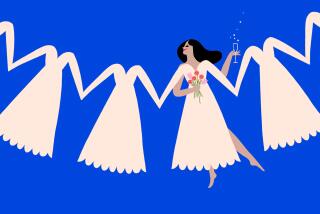Celebrating Different Ways to Say ‘I Do’
Visitors to the World Wedding Festival on Sunday at the Skirball Cultural Center and Museum will be treated to three vastly different wedding ceremonies.
The festivities kick off with a Cambodian wedding ceremony, which features colorful costumes and authentic music. Then, vocalist Prince Diabete, who is from a prominent Manding family in Guinea, will sing, play the lute-harp and tell stories during a West African wedding ceremony. The festivities conclude with a traditional Ashkenazic Jewish wedding with dance music by the Bocivna Klezmer and Michelle Berne’s 12-foot tall puppets, who play the kale and khosm (bride and groom).
Strolling mariachi musicians (because mariachi serenades are a part of traditional Latino weddings) will entertain in the main courtyard and throughout the campus. There will also be workshops, dance instructions and henna hand painting.
The five-hour celebration is being held in conjunction with the Skirball’s new exhibition, “Romance & Ritual: Celebrating the Jewish Wedding,” which opens Saturday and continues through Jan. 6.
Jordan Peimer, curator of the festival and Skirball associate program director, recently discussed the genesis of the wedding festival.
*
Question: Will anybody really be getting married at the festival?
Answer: We basically will have two simulated weddings. There will be no actual marriages. Even in Los Angeles where everybody is up for a spectacular, no one would really want to give over their wedding to complete strangers.
Q: How did the World Wedding Festival come about?
A: The idea came about a year and half or two years ago when the museum decided to do the wedding exhibit. Every August, we do festivals, and they tend to focus on the art of a cultural specific Jewish group. My feeling was that while the exhibition itself is going to be very popular among Jews, the rest of the Los Angeles public may think an exhibition on Jewish weddings has nothing to do with them. My idea was to begin to show that every community has its rituals, and some are very colorful.
I think that there are some real stereotypes of the Jewish wedding that have been promulgated by movies like “Goodbye, Columbus” and “Private Benjamin.” People tend to think of very wealthy weddings, white weddings, with hundreds of guests. In Los Angeles today, there are a lot of Jews who are in very different economic and cultural circumstances. They may have weddings that look much like something you would see in Morocco because that is where their families are from.
Q: How would you describe a traditional Cambodian wedding?
A: It’s very colorful--lots of music, really bright costumes and offerings before altars of fruit and flowers. It’s very beautiful and very spectacle-oriented. It’s kind of the thing an average person would never get to see if they don’t have Cambodian friends. It seemed like a great opportunity to partner with the Cambodian Arts Preservation [group] in Long Beach. They do such amazing things in keeping Cambodian culture alive, and in many ways it echoes the motivation behind the Skirball, which is less about preserving Jewish culture per se than recognizing the history of Jews in America. So the Cambodian groups who are really the first and second generations are trying to find their own ways of keeping their rituals while in America.
Q: The West African wedding sounds like it will be very musical.
A: It is. There will be some storytelling, and dance and there are different instruments that are going to be played--all in a way reflect instruments we are familiar with but have very distinct, different sounds. Prince Diabete will be playing the kora (lute-harp) and will sing and tell stories. He’s part of the griot (oral historians-storytellers), where they are going [to relate] tribal lore. There are going to be two dancers who are going to be doing traditional wedding dances.
Q: Is the old-world Jewish marriage being performed in the Eastern European tradition?
A: It is. I don’t know if you have ever seen Michelle Berne’s puppets, but they are 10 to 12 feet tall. People stand inside of them and they move their arms with poles, so you have these larger-than-life figures. They are very fun. What will happen is what would happen typically in a town in Poland, and will go from the procession through the town with the groom calling upon the bride, the couple journeying to the temple together and the removing of the veil. There will actually be a ceremony where the couple ties the knot, then it will culminate with a full-out wedding celebration with klezmer music. During the course of the day, we are going to have David Dassa, who is a specialist in both Eastern Europe and Israeli folk dance traditions who will be teaching and giving lessons in Eastern European dance.
Q: Besides dance lessons, what other types of workshop are you offering?
A: The kids will be making all kinds of wedding favors. There will be a specific workshop geared toward the decoration to cover the chupah for the puppet bridal couple. The chupah is kind of a covering over the couple that marks the place where the couple gets married.
*
The World Wedding Festival takes place Sunday from 11 a.m. to 4 p.m. at the Skirball Cultural Center and Museum, 2701 N. Sepulveda Blvd., Los Angeles. Museum and festival admission: $8; $6 for students and seniors; free for members and children younger than 6. For tickets and information call (323) 655-8587.
More to Read
The biggest entertainment stories
Get our big stories about Hollywood, film, television, music, arts, culture and more right in your inbox as soon as they publish.
You may occasionally receive promotional content from the Los Angeles Times.











